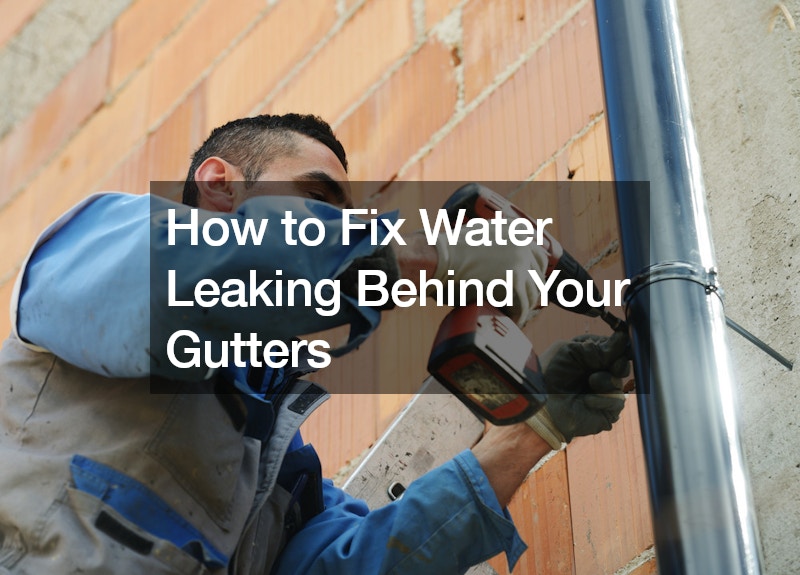
Water leaking behind your gutters can lead to severe damage to your home’s structure, including rotting fascia, soffit, and potentially even your walls. Identifying and addressing this issue promptly is crucial to maintaining the integrity of your home. This post will explore why this problem occurs and offer practical solutions to fix it.
Understanding the Problem
Water leaking behind gutters can result from several scenarios, all related to how water flows from your roof. When water gets behind the gutters, it doesn’t get diverted away from your house as intended, leading to various structural issues.
Understanding the mechanics behind this problem is the first step in addressing it.
Capillary Action and Drip Edges
One common cause of water leaking behind gutters is capillary action. This phenomenon occurs when water travels along a surface due to adhesion and cohesion properties, defying gravity to some extent. When the roof has a low pitch, water can run down the roof, up the drip edge, and then down behind the gutter.
Drip edges are installed to direct water away from the fascia and into the gutters. However, if the drip edge is not installed correctly or the roof has a low pitch, water can bypass this barrier. Ensuring that the drip edge is tightly secured and correctly positioned is essential.
Key Solutions to Prevent Water Leaking
Here are some effective solutions to fix and prevent water from leaking behind your gutters:
1. Inspect and Secure the Drip Edge
The first step in solving this problem is to check the drip edge installation. Make sure it is securely attached and extends over the edge of the gutter. The drip edge should guide water directly into the gutter, preventing it from flowing behind.
If the drip edge is not properly installed, you might notice water running down the fascia instead of entering the gutter. To correct this, you may need to adjust the positioning of the drip edge or replace it if it’s damaged.
2. Seal Loose Shingles
Water can also work its way behind gutters if shingles are not properly adhered to the drip edge. Loose shingles allow water to seep underneath, eventually making its way behind the gutter. Inspect your shingles and ensure they are securely fastened.
If you find loose shingles, reattach them with roofing adhesive. For added protection, you can slide a piece of metal flashing under the shingles and over the drip edge. Apply a thin coat of sealant to the flashing to secure it in place and prevent water from slipping through.
3. Install Flashing
In cases where the drip edge is insufficient to prevent water from leaking behind the gutters, installing additional flashing can be an effective solution. Flashing is a thin piece of metal that redirects water away from critical areas.
- Drip Edge Extension: If the water is traveling back up the drip edge, you can add a drip edge extension. This piece of metal flashing extends the drip edge further into the gutter, ensuring that water flows directly into the gutter rather than behind it.
- Transition Flashing: For added protection, you can install transition flashing. This involves placing a piece of flashing behind the drip edge and ensuring it extends into the gutter. Secure it tightly so that water cannot get behind it.
While these tasks can often be handled by homeowners with some DIY experience, consulting a professional roofing company is advisable for precise installation and to ensure the flashing effectively mitigates water leakage issues.
4. Address Plastic Gutters
Plastic gutters, often installed by DIY enthusiasts, can sometimes exacerbate the problem. These gutters might not have the proper spacing or sealing to prevent water from leaking behind them. Plastic gutters often leave a gap between the fascia and the back of the gutter, providing a path for water to seep through.
To fix this, you can install a Z flashing. A Z flashing is a specially shaped piece of metal that fits over the top of the gutter, down behind it, and then extends out over the front. This directs water into the gutter, ensuring no gaps for water to bypass.
5. Regular Maintenance and Inspection
Regular maintenance is vital in preventing water from leaking behind your gutters. Periodically inspect your roof, shingles, drip edges, and gutters to ensure everything is in good condition. Clean your gutters regularly to prevent clogs that can cause water to overflow and seep behind the gutters.
Key Takeaways
Water leaking behind your gutters is a problem that can lead to significant damage if not addressed promptly. Once you understand the causes and start implementing these simple solutions, you can protect your home from potential damage. Ensure your drip edges are properly installed, secure loose shingles, add necessary flashing, and regularly maintain your gutters. Taking these steps will help keep your home in excellent condition and free from water damage.
.





